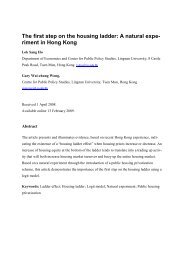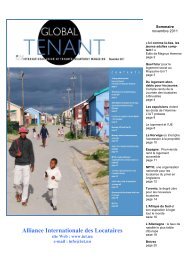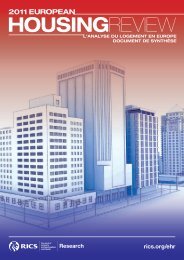housing developments in european countries - Department of ...
housing developments in european countries - Department of ...
housing developments in european countries - Department of ...
Create successful ePaper yourself
Turn your PDF publications into a flip-book with our unique Google optimized e-Paper software.
Section 1<br />
Introduction and Summary<br />
exam<strong>in</strong>ation. Malta, Spa<strong>in</strong> and Italy have the highest<br />
rate <strong>of</strong> vacant dwell<strong>in</strong>gs. As would be expected, <strong>in</strong><br />
view <strong>of</strong> the high numbers <strong>of</strong> tourists who visit these<br />
<strong>countries</strong>, Section 2 <strong>of</strong> this report <strong>in</strong>dicates that the<br />
majority <strong>of</strong> these dwell<strong>in</strong>gs are second homes. The<br />
level <strong>of</strong> empty dwell<strong>in</strong>gs <strong>in</strong> Bulgaria is also above the<br />
European average. Section 2 <strong>of</strong> this report l<strong>in</strong>ks this<br />
high vacancy rate to a decl<strong>in</strong><strong>in</strong>g population and<br />
consequent low <strong>hous<strong>in</strong>g</strong> demand <strong>in</strong> specific regions <strong>of</strong><br />
the country. This phenomenon is also an issue for<br />
regions <strong>of</strong> a number <strong>of</strong> other European <strong>countries</strong><br />
<strong>in</strong>clud<strong>in</strong>g Germany, the Czech Republic, F<strong>in</strong>land and<br />
the United K<strong>in</strong>gdom.<br />
In relation to <strong>hous<strong>in</strong>g</strong> tenure, TABLE 1.4.2 reveals that<br />
69% <strong>of</strong> the <strong>hous<strong>in</strong>g</strong> stock <strong>in</strong> the 28 <strong>countries</strong> under<br />
exam<strong>in</strong>ation is owner-occupied. However, the level <strong>of</strong><br />
owner- occupation varies significantly across Europe.<br />
Romania and Bulgaria have by far the highest levels <strong>of</strong><br />
home ownership – 97.2% and 96.5% <strong>of</strong> dwell<strong>in</strong>gs <strong>in</strong><br />
these <strong>countries</strong> respectively are owner-occupied. Home<br />
ownership rates are generally higher <strong>in</strong> the new EU<br />
member States – <strong>in</strong> Estonia, Hungary, Lithuania and<br />
Slovenia over 80% <strong>of</strong> dwell<strong>in</strong>gs are owner occupied.<br />
This is also the case <strong>in</strong> Spa<strong>in</strong>, Greece and Italy. In<br />
contrast, Sweden and Germany have the lowest rates<br />
<strong>of</strong> owner occupation amongst the <strong>countries</strong> under<br />
exam<strong>in</strong>ation.<br />
6 European Union Report<br />
As would be expected, <strong>in</strong> those <strong>countries</strong> where owneroccupancy<br />
rates are very high, the rental <strong>hous<strong>in</strong>g</strong><br />
sector is consequently modest <strong>in</strong> size and vice versa.<br />
On average 16.9% <strong>of</strong> dwell<strong>in</strong>gs were private rented <strong>in</strong><br />
the 28 <strong>countries</strong> under exam<strong>in</strong>ation. However, there<br />
are no private rented dwell<strong>in</strong>gs <strong>in</strong> Bulgaria and<br />
Romania, while <strong>in</strong> Slovenia only 2.6% <strong>of</strong> dwell<strong>in</strong>gs are<br />
private rented. Among the 28 <strong>countries</strong> under<br />
exam<strong>in</strong>ation 10.1% <strong>of</strong> dwell<strong>in</strong>gs are social rented.<br />
Although levels <strong>of</strong> social rented are higher <strong>in</strong> the 15<br />
long-stand<strong>in</strong>g EU members (where an average <strong>of</strong><br />
12.2% <strong>of</strong> dwell<strong>in</strong>gs are social rented), <strong>in</strong> comparison<br />
with the 10 new EU members (where an average <strong>of</strong><br />
7% <strong>of</strong> dwell<strong>in</strong>gs are social rented), the distribution <strong>of</strong><br />
social rented dwell<strong>in</strong>gs is uneven <strong>in</strong> both groups <strong>of</strong><br />
<strong>countries</strong>. The average figure for social rented<br />
dwell<strong>in</strong>gs <strong>in</strong> the long-stand<strong>in</strong>g EU members is skewed<br />
by Sweden, Denmark and the Netherlands where over<br />
22% <strong>of</strong> dwell<strong>in</strong>gs are social rented. By contrast, with<br />
the exception <strong>of</strong> Poland and the Czech Republic, <strong>in</strong> a<br />
majority <strong>of</strong> the new EU member States under 7% <strong>of</strong><br />
dwell<strong>in</strong>gs are social rented.<br />
The ‘other’ category <strong>in</strong> TABLE 1.4.2 encompasses a<br />
wide range <strong>of</strong> types <strong>of</strong> <strong>hous<strong>in</strong>g</strong> <strong>in</strong>clud<strong>in</strong>g: dwell<strong>in</strong>gs<br />
provided by employers and religious <strong>in</strong>stitutions and<br />
dwell<strong>in</strong>gs occupied free <strong>of</strong> rent. This category also<br />
<strong>in</strong>cludes co-operative ownership <strong>hous<strong>in</strong>g</strong> <strong>in</strong> the<br />
follow<strong>in</strong>g <strong>countries</strong>: the Czech Republic (where 12%<br />
<strong>of</strong> the <strong>hous<strong>in</strong>g</strong> stock is <strong>in</strong> this category), F<strong>in</strong>land (1%<br />
<strong>of</strong> dwell<strong>in</strong>gs), Poland (19.3%), Slovakia (14.9%) and<br />
Sweden (16%). The nature <strong>of</strong> the co-operative<br />
ownership sector varies <strong>in</strong>ternationally. In some<br />
<strong>countries</strong>, occupants <strong>of</strong> co-operative ownership<br />
<strong>hous<strong>in</strong>g</strong> enjoy similar rights and duties to owner<br />
occupiers; <strong>in</strong> others they own only a small proportion<br />
<strong>of</strong> the equity <strong>in</strong> their homes. Further details <strong>of</strong> these<br />
arrangements are provided <strong>in</strong> Section 2 <strong>of</strong> this report.<br />
The reasons for these <strong>in</strong>ternational variations <strong>in</strong> tenure<br />
patterns are manifold and complex. However, Section<br />
2 <strong>of</strong> this report reveals that <strong>in</strong> the case <strong>of</strong> the 8 CEE<br />
new EU members, together with Bulgaria and<br />
Romania, the methods used to privatise the Stateowned<br />
dwell<strong>in</strong>gs, which prior to the economic and<br />
political re-organisation <strong>of</strong> these <strong>countries</strong> <strong>in</strong> the early<br />
1990s was the dom<strong>in</strong>ant form <strong>of</strong> <strong>hous<strong>in</strong>g</strong> provision,<br />
particularly <strong>in</strong> urban areas, had a key impact on the<br />
<strong>hous<strong>in</strong>g</strong> tenure structure. In most cases this process<br />
was carried out <strong>in</strong> two stages. Firstly ownership <strong>of</strong> the<br />
dwell<strong>in</strong>gs was transferred to the local authorities,<br />
which then sold them to occupants at large discounts.<br />
S<strong>in</strong>ce the mid-1990s a number <strong>of</strong> these <strong>countries</strong>,<br />
<strong>in</strong>clud<strong>in</strong>g Lithuania, Romania and Slovenia, have<br />
prohibited further sales <strong>of</strong> social <strong>hous<strong>in</strong>g</strong> units, while<br />
<strong>in</strong> Bulgaria and Estonia the number <strong>of</strong> sales has been<br />
few, due to the limited size <strong>of</strong> the rema<strong>in</strong><strong>in</strong>g social<br />
rented sector. Although sales <strong>of</strong> dwell<strong>in</strong>gs still take<br />
place <strong>in</strong> the Czech Republic and Poland, sales <strong>of</strong><br />
municipal-owned dwell<strong>in</strong>gs have slowed somewhat <strong>in</strong><br />
recent years <strong>in</strong> Poland.<br />
TABLE 1.4.3 exam<strong>in</strong>es a second key feature <strong>of</strong> the<br />
Table<br />
1.4.3<br />
Hous<strong>in</strong>g Quality <strong>in</strong> European Countries, Various Years<br />
Date <strong>of</strong> Construction (DC) (%) Available Facilities (AF) (%)<br />
Average Floor<br />
Number Area<br />
Pre- 1945- 1970- 1990- Runn<strong>in</strong>g Bath/ Central <strong>of</strong> Rooms (FA)<br />
Country Year to which data refer 1945 1970 1990 Present Water Lavatory Shower Heat<strong>in</strong>g (AR) (<strong>in</strong> m 2 )<br />
Austria 2002 26.8 28 28.7 16.4 99.9 98.7 97.5 87.3 4.3 60-90<br />
Belgium 1996 31.8 29.8 34.1 4.2 Nav Nav Nav Nav Nav Nav<br />
Bulgaria 2000 24.3 48.2 24.5 1.9 97.6 82.5 Nav 12.7 2.6 65.2<br />
Cyprus* DC, AR, FA=2000; AF-1999 23* 10.7 38.1 28.2 99.2 97.7 94.8 50 5.8 144.8<br />
Czech Republic DC=1991; AF, FA=2001; AR= 2000 41.9 24.6 33.5 0** 98.5 95.4 95.5 81.7 2.7 49.3<br />
Denmark DC, FA=2000; AF=2003 38.9 29.9 25.9 5.3 99.9 99.9 94.3 99.9 Nav 109.3<br />
Estonia**** DC, AF=2002; AR, AF=2000 18.9 22.8 31.5 4.1 82 72 68 59 3.8 68.9<br />
F<strong>in</strong>land DC=1996; AF=2002; AR, FA=2000 12 32.9 46.2 7.9 98 96 99 92 3.8 85.7<br />
Note:<br />
* <strong>in</strong> these cases the<br />
data on date <strong>of</strong><br />
construction<br />
supplied by <strong>hous<strong>in</strong>g</strong><br />
m<strong>in</strong>istries were not<br />
orig<strong>in</strong>ally organised<br />
<strong>in</strong>to the categories<br />
utilised above.<br />
These data were<br />
therefore<br />
reclassified for the<br />
purpose <strong>of</strong><br />
<strong>in</strong>clud<strong>in</strong>g it <strong>in</strong> this<br />
table.<br />
See: Section 1 <strong>of</strong><br />
this report for the<br />
orig<strong>in</strong>al data.<br />
France* 2002 29.4* 15.1 32.2 5.7 99.9 99.2 99.2 96.3 4 90<br />
Germany* DC=2002; FA=1996 27.9* 61 11.1 Nav Nav Nav Nav Nav 88.4<br />
Greece N/A Nav Nav Nav Nav Nav Nav Nav Nav Nav Nav<br />
** these data only<br />
cover the period to<br />
1990.<br />
Regular National Report on Hous<strong>in</strong>g Developments <strong>in</strong> European Countries<br />
7<br />
Hungary* DC, AF=1996; AR, FA=2000 29.5 27.2 38.9 4 84.4 75.6 79.6 48.2 4.1 52<br />
Ireland* 2002 20.5 17.6 36.2 25.7 99.7 Nav Nav 86.8 5.2 70.2<br />
Italy DC=1991; AF=1995; FA=1996 29.5 40.7 29.8 99 99 99 79 Nav 88.3<br />
Latvia 2000 25 28 43 4 83.2 77.8 67 64.9 2-3 40-60<br />
Lithuania DC, AF, AR=2001; FA=2000 27 34 32 7 78.9 76.3 71.8 72 2-3 70.9<br />
Luxembourg DC, AR=2001; FA=1999 27.3 72.7 100 100 100 100 Nav 81.1<br />
Malta 1995 25.5 22.2 43.1 9.1 99 97.7 96.6 0.7 5 Nav<br />
Netherlands DC, AF= 2002; AR=2000 20 27 53 100 100 100 90 4.2 Nav<br />
Poland DC, AF, AR=2002, FA= 1991 23.2 26.9 37 11.6 92.5 80.6 80.8 71.4 3.7 49<br />
Portugal 1991 24.4 31.2 44.2 0 87.2 88.8 82.2 Nav Nav Nav<br />
Romania 2002 Nav Nav Nav Nav 53 53 Nav Nav 2.6 Nav<br />
Slovakia 2001 11.5 35.2 46.6 6.7 94.7 60.2 62.2 76.3 3 40-60<br />
Slovenia 2002 23.4 39.8 28.9 7.8 98.5 93 92 78.6 3 74.6<br />
Spa<strong>in</strong> 2001 22 29.8 34.3 13.8 98.6 96.8 Nav 53.2 5 76-90<br />
Sweden DC=2002; AF=2000, AR=1990; FA=1996 21 43 28 6 100 100 100 100 4.2 71<br />
Turkey AR=2000 Nav Nav Nav Nav 94.7 88 94.9 100 Nav 80-100<br />
United K<strong>in</strong>gdom* 1991 41 22 38 0*** Nav Nav Nav Nav Nav Nav<br />
Mean (R) N/a 28.8 34.8 37.6 8.2 93.3 88.2 88.7 72.7 3.6 76.5<br />
Source: additional <strong>in</strong>formation was sourced <strong>in</strong> the United Nations Economic Commission for Europe (2002).<br />
*** these data only<br />
cover the period to<br />
1996.<br />
**** 22.8% <strong>of</strong> the<br />
<strong>hous<strong>in</strong>g</strong> stock <strong>in</strong><br />
Estonia is<br />
categorised as<br />
unknown <strong>in</strong> terms<br />
<strong>of</strong> age. The<br />
<strong>in</strong>formation on the<br />
average age <strong>of</strong><br />
dwell<strong>in</strong>gs <strong>in</strong> each<br />
<strong>hous<strong>in</strong>g</strong> tenure is<br />
skewed by miss<strong>in</strong>g<br />
data for some<br />
<strong>countries</strong>. As a<br />
result the average<br />
values <strong>in</strong> the four<br />
age categories<br />
exceeds 100%.<br />
Where floor space<br />
data refer to a<br />
range (e.g. 80-100<br />
m 2 ) the <strong>in</strong>terval<br />
figure was used to<br />
calculate the mean.<br />
Introduction and Summary Section 1

















